NASA Perseverance rover pulls breathable oxygen from air on Mars
A golden, toaster-size device pulls oxygen from the Martian atmosphere, which is about 96% carbon dioxide.

An instrument on the Perseverance rover has extracted oxygen from the Martian atmosphere.
A day after flying a helicopter on another planet, the team behind NASA's Perseverance rover accomplished another big first on Mars. The vagabonding science lab managed to pull oxygen out of the Martian atmosphere, which is about 96% carbon dioxide.
The rolling robot carries an experimental instrument about the size of a toaster called the Mars Oxygen In-Situ Resource Utilization Experiment, known as Moxie, and on Tuesday it succeeded in peeling the oxygen atoms off molecules of carbon dioxide to create oxygen.
"This is a critical first step at converting carbon dioxide to oxygen on Mars," Jim Reuter, associate administrator of NASA's Space Technology Mission Directorate, said in a statement. "MOXIE has more work to do, but the results from this technology demonstration are full of promise as we move toward our goal of one day seeing humans on Mars."
Reuter adds that similar technology could be used to create rocket propellant and breathable air for future explorers.
In its first run, Moxie extracted about five grams of oxygen, or the equivalent of around 10 minutes worth of breathable oxygen for one person. The device is designed to create up to 10 grams of oxygen per hour, so you wouldn't want to rely on it for your survival, but NASA hopes that more powerful successors could be used to produce many tons of oxygen over their lifetimes.
Here's a look at Moxie's innards.
The plan is for Moxie to extract oxygen at least nine more times during the first two years of the rover's journey.
Moxie's principal investigator, Michael Hecht, says the team will introduce "new wrinkles, such as a run where we compare operations at three or more different temperatures." He adds that they "will try running the experiment under different conditions, times of day and seasons. ... We'll push the envelope."
Bottom line: When astronauts take their first breaths of locally produced oxygen on Mars, they may have this gold, toaster-size gadget to thank.
Follow CNET's 2021 Space Calendar to stay up to date with all the latest space news this year. You can even add it to your own Google Calendar.

